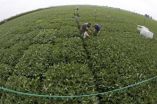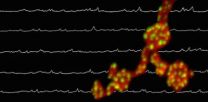(Press-News.org) The rapid melting of Greenland glaciers is captured in the documentary "Chasing Ice." The retreat of the ice edge from one year to the next sends more water into the sea.
Now University of Washington atmospheric scientists have estimated that up to half of the recent warming in Greenland and surrounding areas may be due to climate variations that originate in the tropical Pacific and are not connected with the overall warming of the planet. Still, at least half the warming remains attributable to global warming caused by rising carbon dioxide emissions. The paper is published May 8 in Nature.
Greenland and parts of neighboring Canada have experienced some of the most extreme warming since 1979, at a rate of about 1 degree Celsius per decade, or twice the global average.
"We need to understand why in the last 30 years global warming is not uniform," said first author Qinghua Ding, a UW research scientist in atmospheric sciences. "Superimposed on this global average warming are some regional features that need to be explained."
The study used observations and advanced computer models to show that a warmer western tropical Pacific Ocean has caused atmospheric changes over the North Atlantic that have warmed the surface by about a half-degree per decade since 1979.
"The pattern of the changes in the tropical Pacific that are responsible for remarkable atmospheric circulation changes and warming in Greenland and the Canadian Arctic are consistent with what we would call natural variability," said co-author David Battisti, a UW professor of atmospheric sciences.
Researchers say it's not surprising to find the imprint of natural variability in an area famous for its melting ice. In many of the fastest-warming areas on Earth, global warming and natural variations both contribute to create a "perfect storm" for warming, said co-author John "Mike" Wallace, a UW professor of atmospheric sciences.
The natural variations in the new study related to an unusually warm western tropical Pacific, near Papua New Guinea. Since the mid-1990s the water surface there has been about 0.3 degrees hotter than normal. Computer models show this affects the regional air pressure, setting off a stationary wave in the atmosphere that arcs in a great circle from the tropical Pacific toward Greenland before turning back over the Atlantic.
"Along this wave train there are warm spots where the air has been pushed down, and cold spots where the air has been pulled up," Wallace said. "And Greenland is in one of the warm spots."
In previous studies, Wallace and Battisti have documented the existence of decades-long climate variations in the Pacific Ocean that resemble the well-known shorter-range El Niño variations.
This particular location in the tropical Pacific may be a "sweet spot" for generating global atmospheric waves. A series of studies led by co-author Eric Steig, a UW professor of Earth and space sciences, working with Ding and Battisti, showed that waves starting in the same place but radiating southward are warming West Antarctica and melting the Pine Island Glacier.
Researchers can't say for how long the tropical Pacific will remain in this state.
"Our work shows that about half of the warming signal in Greenland comes from the predictable part – forcing of climate by anthropogenic greenhouse gases – but about half comes from the unpredictable part," Steig said.
This makes shorter-term forecasts difficult, but helps scientists to make more accurate long-range projections.
"Nothing we have found challenges the idea that globally, glaciers are retreating," Battisti said. "We looked at this place because the warming there is really remarkable. Our findings help us to understand on a regional scale how much of what you see is human-induced by the buildup of CO2, and how much of it is natural variability."
The dramatic message of "Chasing Ice" remains true, authors say.
"There's nothing in this paper that negates the message in the movie," Wallace said. "Ice appears to be exquisitely sensitive to the buildup of greenhouse gases, more than we ever would have thought." Natural variations could either accelerate or decelerate the melting rate of Greenland's glaciers in coming decades, he said, but "in the long run, the human-induced component is likely to prevail."
INFORMATION:
The research was funded by the National Science Foundation, UW's Quaternary Research Center, the National Basic Research Program of China and the APEC Climate Center. Other co-authors are Lei Geng at the UW; Ailie Gallant at Australia's Monash University; and Hyung-Jin Kim at South Korea's APEC Climate Center.
For more information, contact Ding at qinghua@uw.edu, Wallace at 206-543-7390 or wallace@atmos.washington.edu, Battisti at 206-543-2019 or battisti@uw.edu, and Steig at 206-685-3715 or steig@uw.edu.
Greenland melting due equally to global warming, natural variations
2014-05-07
ELSE PRESS RELEASES FROM THIS DATE:
As CO2 levels rise, some crop nutrients will fall
2014-05-07
CHAMPAIGN, Ill. — Researchers have some bad news for future farmers and eaters: As carbon dioxide levels rise this century, some grains and legumes will become significantly less nutritious than they are today.
The new findings are reported in the journal Nature. Eight institutions, from Australia, Israel, Japan and the United States, contributed to the analysis.
The researchers looked at multiple varieties of wheat, rice, field peas, soybeans, maize and sorghum grown in fields with atmospheric carbon dioxide levels like those expected in the middle of this century. ...
Scientists create first living organism that transmits added letters in DNA 'alphabet'
2014-05-07
LA JOLLA, CA—May 7, 2014—Scientists at The Scripps Research Institute (TSRI) have engineered a bacterium whose genetic material includes an added pair of DNA "letters," or bases, not found in nature. The cells of this unique bacterium can replicate the unnatural DNA bases more or less normally, for as long as the molecular building blocks are supplied.
"Life on Earth in all its diversity is encoded by only two pairs of DNA bases, A-T and C-G, and what we've made is an organism that stably contains those two plus a third, unnatural pair of bases," said TSRI Associate Professor ...
Vascular simulation research reveals new mechanism that switches in disease
2014-05-07
BOSTON -- Blood vessel formation is critical to life and its manipulation is instrumental to a number of diseases. For more than 40 years, investigations into the structure and function of endothelial cells lining the blood vessels have revealed a complex tissue with complex functions, demonstrating that endothelial cells participate in all aspects of vascular homeostasis and pathological processes.
Today, important revelations regarding endothelial cell behavior are emerging from vascular simulation research, a blossoming interdisciplinary field that makes use of novel ...
Airborne measurements confirm leaks from oil and gas operations
2014-05-07
During two days of intensive airborne measurements, oil and gas operations in Colorado's Front Range leaked nearly three times as much methane, a greenhouse gas, as predicted based on inventory estimates, and seven times as much benzene, a regulated air toxic. Emissions of other chemicals that contribute to summertime ozone pollution were about twice as high as estimates, according to the new paper, accepted for publication in the American Geophysical Union's Journal of Geophysical Research: Atmospheres.
"These discrepancies are substantial," said lead author Gabrielle ...
Astronomers create first realistic virtual universe
2014-05-07
Move over, Matrix - astronomers have done you one better. They have created the first realistic virtual universe using a computer simulation called "Illustris." Illustris can recreate 13 billion years of cosmic evolution in a cube 350 million light-years on a side with unprecedented resolution.
"Until now, no single simulation was able to reproduce the universe on both large and small scales simultaneously," says lead author Mark Vogelsberger (MIT/Harvard-Smithsonian Center for Astrophysics), who conducted the work in collaboration with researchers at several institutions, ...
Brain noise found to nurture synapses
2014-05-07
NEW YORK, NY (May 7, 2014) — A study has shown that a long-overlooked form of neuron-to-neuron communication called miniature neurotransmission plays an essential role in the development of synapses, the regions where nerve impulses are transmitted and received. The findings, made in fruit flies, raise the possibility that abnormalities in miniature neurotransmission may contribute to neurodevelopmental diseases. The findings, by researchers at Columbia University Medical Center (CUMC), were published today in the online edition of the journal Neuron.
The primary way ...
Native algae species to blame for 'rock snot' blooms in rivers worldwide
2014-05-07
VIDEO:
The recent appearance of the freshwater algae known as "rock snot " on river bottoms worldwide is caused by a native species responding to changing environmental conditions rather than by accidental...
Click here for more information.
The recent blooms of the freshwater algae known as "rock snot" on river bottoms worldwide are caused by a native species responding to changing environmental conditions rather than by accidental introductions by fishermen or the ...
Early depression, anger may taint love life even 20 years later, study shows
2014-05-07
A University of Alberta study is helping crack the code to happiness by exploring the long reach of depression and anger over more than two decades.
The study, published recently in the Journal of Family Psychology, followed 341 people for 25 years, and found that negative emotions they may have suffered as young adults can have a lasting grip on their couple relationships, well into middle age.
The fact that depression and anger experienced during the teen years clung to people, even through major life events such as child-rearing, marriages and careers was surprising, ...
Community doulas can be a big help for mother-baby relationships
2014-05-07
Young mothers are more likely to breastfeed and have positive relationships with their babies when they have another woman "mothering" them in the delivery room, according to new research at the University of Chicago on the value of doulas—women who help with deliveries and early care for mothers and babies.
The assistance from doulas is particularly valuable to young mothers from disadvantaged backgrounds. Those mothers sometimes receive help from women known as community doulas, who are from similar backgrounds as the young women and who visit them weekly for several ...
Emerald ash borers were in US long before first detection
2014-05-07
EAST LANSING, Mich. — New research at Michigan State University shows that the uber-destructive emerald ash borer arrived at least 10 years before it was first identified in North America.
The study, published in the current issue of journal Diversity and Distributions, shows that EABs were feasting on ash trees in southeast Michigan by the early 1990s, well before this pest was discovered in 2002, said Deb McCullough, MSU professor of forest entomology.
"We suspect they arrived inside wood crating or pallets imported from Asia where the beetle is native," she said. ...




